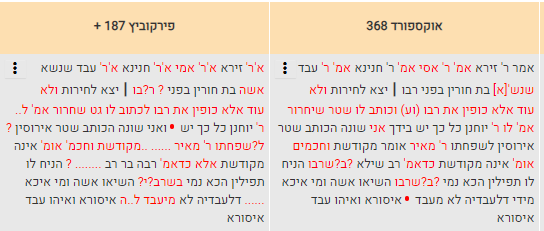The Impossibility of the Rav Ashi Citation Chain
A quick thought on Gittin 39b:
אָמַר רַבִּי זֵירָא, אָמַר רַבִּי חֲנִינָא, אָמַר רַב אָשֵׁי, אָמַר רַבִּי: עֶבֶד שֶׁנָּשָׂא אֶת בַּת חוֹרִין בִּפְנֵי רַבּוֹ –
Rabbi Zeira says that Rabbi Ḥanina says that Rav Ashi says that Rabbi Yehuda HaNasi says: In the case of a slave who marries a free woman in the presence of his master,
I don’t understand how the various translations could allow this citation chain to stand. Rav Ashi is of a later generation than Rabbi Zeira I or II, and wouldn’t be immediately before Rabbi Yehuda HaNasi! They could only leave this alone if they didn’t give any thought whatsoever to the scholastic generations in this citation chain.
A quick look at Hachi Garsinan vindicates my extreme reservations.
The three printings have this extreme strangeness:
As for manuscripts, Munich 95 does preserve Rav Ashi, but at least reverses the order somewhat, putting Rabbi Chanina after him in the chain.
However, Rabbi Zeira in that position still makes absolutely no sense, as citing Rav Ashi!
I wonder if the text of the statement could have introduced a spurious Rav Ashi. Because the next line in the manuscript begins:
So the R’ for Rabbi and the Ash’ for Isha could combine together to introduce a Rav Ashi.
Also, רבו could become Rabbi. So we have Rav Ashi citing Rabbi.
Vatican 130 matches Vatican 130, reversing the order but it still makes little sense to have Rabbi Zeira cite it:
However, other manuscripts solve this in other manner. Namely, they have either R’ Ami or R’ Asi, or Rav Asi.
Thus, Arras has R’ Asi with the order inverted so that Rabbi Zeira cites him.
This would be fourth-generation Rabbi Zeira citing third generation Rabbi Asi, I think. Oxford 368 also has Rabbi Asi in the lineup. Firkowitz 187 has Rabbi Ami, a contemporary, instead, with the inverted order:
Finally, Vatican 140 also has Rabbi Ami, with the inverted order.
My best guess is Rabbi Asi as original, because that minimizes the distance each manuscript must make to its destination. Namely, the R’ Asi manuscripts require no change, the R’ Ami manuscripts make a simple and understandable change for Ami in place of Asi, since these contemporaries often travel together and are exchange for each other. And Asi to Ashi is a simple sound change, when the Talmud was transmitted orally, or when a scribe somehow repeated it orally to himself when copying. The three printings then somehow inverted the order, placing Rav Ashi right before Rabbi.
Although see what I wrote above regarding Isha and Rabbo. If those turned into Ashi and Rabbi, we can understand the strange phenomenon of four rabbis being cited in a chain, and Ashi out of that chain.
Finally, if it were Rav Asi, then that first-generation Babylonian Amora might be in the right position immediately before Rabbi Yehuda HaNasi.









